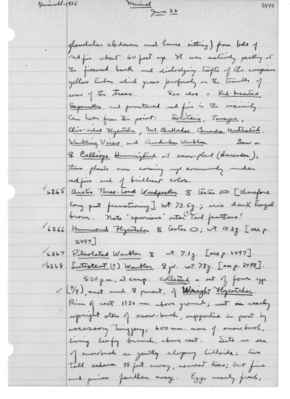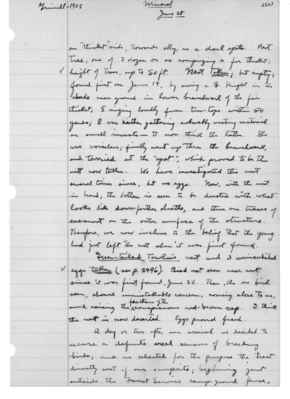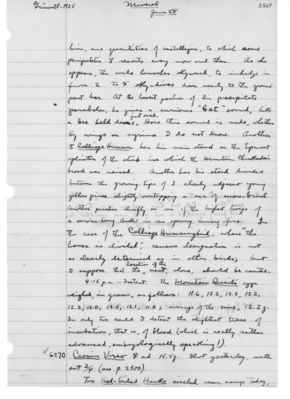Pages That Mention fir
1925: Joseph Grinnell's field notes
S2 Page 45
Collector: Grinnell - 1925 Location: Mineral Date: June 26 Page Number: 2499
glandular abdomen and hence sitting) from bole of red fir about 60 feet up. It was actively pecking at the fissured bark and dislodging tufts of the conspicuous yellow lichen which grows profusely on the trunks of some of the trees. Saw also a Red-breasted Sapsucker, and punctured red fir in the vicinity. Can hear from this point: Solitaire, Tanager, Olive-sided Flycatcher, Mt. Chickadee, Canada Nuthatch, Warbling Vireo, and Audubon Warbler. Saw a [female symbol] Calliope Hummingbird at snow-plant (Sarcodes); these plants now coming up commonly under red firs and of brilliant colors.
6265 Arctic Three-toed Woodpecker [male symbol] testes [illustration] [therefore long past functioning] wt. 73.5g.; iris dark hazel brown. Note "spurious" outer ^(?) tail feathers!
6266 Hammond Flycatcher [male symbol] testes [illustration]; wt. 10.2g. [see p. 2497].
6267 Pileolated Warbler [male symbol] wt. 7.1g. [see p. 2497].
6268 Lutescent (?) Warbler [female symbol] jv. wt. 7.8g. [see p. 2498].
5:00p.m., at camp: collected a set of four eggs 4/4, nest and female parent, of Wright Flycatcher. Rim of nest 1130mm above ground; nest on nearly upright stem of snow-bush, supported in part by accessory twiggery; 600 mm. more of snow bush, living leafy branch, above nest. Site in sea of snowbush on gently sloping hillside; two tall cedars 75 feet away, nearest trees; but firs and pines farther away. Eggs nearly fresh;
S2 Page 46
Collector: Grinnell - 1925 Location: Mineral Date: June 26 Page Number: 2500
nest found ten days ago, barely began; 3 eggs in nest day before yesterday.
6269 Wright Flycatcher [female symbol] with set 4/4 11.0 g. Had evidently had an accident by which a lot of feathers on back were lost, there being now in process of replacement. Possibly, delayed nesting due to this accident.
June 27 4 p.m. - Cassin Vireo's nest: rim 1750 mm. above ground; nest near end of drooping cedar branch, 7 feet out ^(on south side) from trunk of tree, which is 15 inches in diameter 3 feet from ground. Site about 10 yards from edge of willow bog on one side and less distance from heavy stand of firs, on the other side; lodgepole pines bordering bog close by. This nest was found partly built on the 15th, empty but seemingly completed on the 20th, now with 4 fresh or nearly fresh eggs ^(two of them) and female incubating. Taken, set 2/4. Male bird sang awhile, then went away. After I had waited 20 minute, the [female symbol] came quietly, and I "collected" her.
5 p.m. - Traill Flycatcher nest and set 1/4, taken. Nest, not quite completed, found on 20th, now four eggs, nearly or quite fresh; birds close about me. Nest in dense willow jungle. Rim only 1040 mm. above running water of creek, here entirely overgrown with matted willows. Nest on slanting stems, overtopped by fully 5 feet of lush willow growth.
S2 Page 48
Collector: Grinnell - 1925 Location: Mineral Date: June 28 Page Number: 2502
her wings. As the [sic] left, in a hurry, the positions of some of the eggs changed; one egg was thrown up the side of the nest a bit. Set taken, 1/9 [See p. 2507]. As previously stated (p. 2481) the nest is on a log, this being old and rotten, flattish on top, even lengthwise hollow or depressed at the point where the nest is. In this longitudinal groove (as it were) is an accumulation of bits of rotten wood, old cone scales, and brown dry last-year's ceanothus leaves. The "nest" is a saucer-shaped depression in this mixture of debris, about 150 mm. across (measured) by 35 mm. deep. About a dozen feathers of the quail enter into the "lining." The whole site is well concealed and protected by the flattened, thorny branches and dead twiggery of the snow-brush which sprawls over the log from the south side. A heavy clump of young firs grows 25 feet to the south and west and serves to shade the place most of the afternoon
Ruby-crowned Kinglet's nest: rim 5180 mm. above ground; in young white fir, 10 inches in diameter 3 ft. from ground; nesting, with practically no attachment on flat mass of fir bough - stem, ^live twigs and needles beneath. Bough, from bole of tree, slightly drooping, towards southwest - sunny exposure. Nest out on bough 960 mm. from bole, in from extreme end of bough 880 mm. Could be seen from ground only
S2 Page 49
Collector: Grinnell - 1925 Location: Mineral Date: June 28 Page Number: 2503
on "thicket" side, towards sky, as a dark spot. Nest tree, one of 2 dozen or so comprising a fir thicket; height of trees, up to 50 ft. Nest taken; but empty; found first on June 14, by seeing a [female symbol] Kinglet inthe shade near ground in lower branchwork of the fir thicket; [male symbol] singing loudly from tree-tops within 50 yards; [female symbol] was either gathering cobwebby nesting material or small insects - I now think the latter. She was voiceless; finally went up thru the branchwork, and tarried at the "spot", which proved to be the nest now taken. We have investigated this nest several times since, but no eggs. Now, with the nest in hand, the bottom is seen to be dusted with what looks like down-feather sheaths, and there are traces of excrement on the outer surface of the structure. Therefore, we now incline to the belief that the young had just left the nest when it was first found.
Green-tailed Towhee's nest and 3 unincubated eggs taken (see p. 2496). Bird not seen near nest since it was first found, June 25. Then, the one bird seen, showed unmistakable concern, coming close to me, and raising the ^feathers of the conspicuous red-brown cap. I think the nest is now deserted. Eggs proved fresh.
A day or two after our arrival we decided to secure a definite areal census of breeding birds; and we selected for the purpose the tract directly west of our campsite; beginning just outside the Forest Service camp-ground fence,
S2 Page 53
Collector: Grinnell - 1925 Location: Mineral Date: June 28 Page Number: 2507
him, are quantities of castillejas, to which some peripatetic [female symbol] resorts every now and then. As she appears, the male launches skyward, to indulge in from 2 to 5 sky-dives down nearly to the ground past her. At the lowest portion of this precipitate parabola, he gives a curious "bzt" sound, like a bee held down, ^just once. How the sound is made, whether by wings or syrinx I do not know. Another [male symbol] Calliope Hummer has his main stand on the tipmost splinter of the stub in which the Mountain Chickadee's brood was raised. Another has his stand divided between the growing tips of 3 closely adjacent young yellow pines slightly overtopping a sea of snow-brush. Another perches chiefly on one of the highest twigs of a service-berry thicket in an opening among firs. In the case of the Calliope Hummingbird, where "the house is divided," census designation is not as clearly determined as in other birds; but I suppose that the ^location of the nest, alone, should be counted.
4:15 p.m. - Intent. The Mountain Quail's eggs weighed, in grams, as follows: 11.6, 12.2, 12.3, 13.2, 12.2, 12.0, 12.5, 12.1, 11.4; average of the nine, 12.2 g. In only two could I detect the slightest trace of incubation, that is, of blood (which is really rather advanced, embryonically speaking!).
6270 Cassin Vireo [female symbol] ad. 15.5 g. Shot yesterday, with set 2/4 (see p. 2500).
Two Red-Tailed Hawks circled near camp today,




